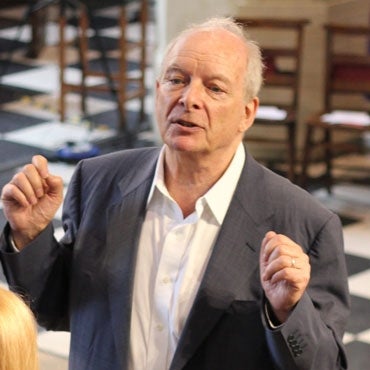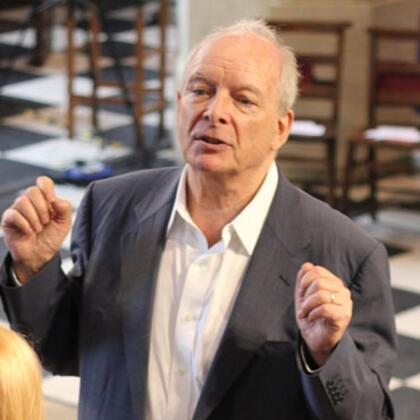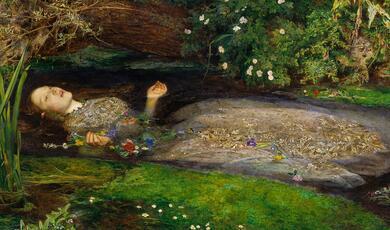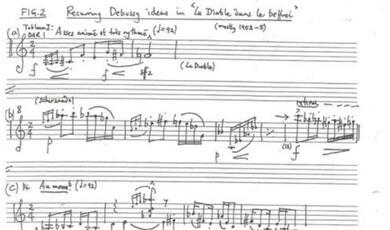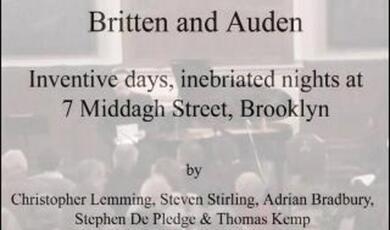Beethoven: String Quartet in F major, Op. 18 No.1
With the Wilhelm Quartet
How to be revolutionary without scaring away your public? How to announce yourself as a new broom without alienating the more stalwart connoisseurs? Beethoven faced these problems when presenting his first six string quartets for publication as opus 18; did he win his public and allay their fears with his choice of opening? The Wilhelm Quartet will present the evidence.
The Wilhelm Quartet comprises Marciana Buta (violin), Charlotte Skinner (violin), Daisy Spiers (viola) and Hetty Snell (cello).
This is a part of Professor Hogwood's 2011-12 series of lectures, The Making of a Masterpiece, in which he examines a number of acknowledged masterpieces, but each from a select angle only - their scoring, compactness, virtuosity, accessibility, memorability or other flavour.
20 March 2012
The Making of a Masterpiece:
The Opening Salvo
Professor Christopher Hogwood CBE
Good afternoon. I am joined today by the Wilhelm String Quartet, who are going to play a complete Beethoven String Quartet later on in this production.
In my last lecture, I got very excited about the originality and the uniqueness of Mozart – the Amadeus effect - and we talked a lot about a wonderful individual mind and a very original and unique solution to problems. You also heard the devilish tricks of the Mozart Oboe Quartet. The logical follow-up is to put forward the more businesslike side of the picture. A career as a composer, certainly in the eighteenth and nineteenth centuries, is not necessarily based on total originality. It is more akin to jumping on a moving bus with some aplomb in order to make people notice that, as an extra passenger, you are worth looking at. Someone once said, very effectively, that the painter who paints a tree is not doing so because he wants to paint a tree or because he has seen a tree, he is painting because he has seen a painting of a tree. This makes a big difference to the working life of a composer getting to grips with the fact that you have to join a vehicle which has already been in motion for some time.
The originator of the string quartet, most simply, although not completely accurately, is Haydn. I think everybody plays Haydn string quartets as a usual starting point, and so he gets this cosy title of the ‘Father of the String Quartet’. He drew on what was already available, but produced such a body of string quartets that they were established as an important unit. The string quartet has remained a very important unit of classical music composition ever since, along with the opera, the symphony and the sonata.
So, the next person to come along has to do something pretty amazing in order to join this moving vehicle, and that was Mozart. He turned up in Vienna, aged about 28. He studied fugue and a lot of the earlier tricks of composition from the more pedantic teachers in order to add these qualities to his already very effective, very theatrical compositions, and some of the noteworthy things he first produced were a set of string quartets. Obviously, he dedicated these to Haydn.
Next to arrive in Vienna, at about the same age of 28, was Beethoven. He was doing exactly the same thing: looking back at the legacy of the string quartet as it had been established and played by amateurs and professionals and published, and he saw, as Mozart saw, that there was a need to have terrific classical, almost baroque grounding. You had to really know harmony, counterpoint etc. You had to learn how to include the characteristics of learned composition; it is quite clear that, for his whole life, Beethoven struggled with this ogre of the baroque fugue and how it could be reclaimed for classical music. The Groβe Fuge is one of the last great pieces he wrote, again with string quartet in mind, and which stretches, some people may say bursts, the bounds of the strict definition of fugue. But Beethoven took contrapuntal lessons and then decided, when he had worked on a set of quartets, he would show the world what he could do in this established form. Immediately, as soon as the Opus 18 quartets appear, they are compared with Mozart before him, and with Haydn before that. Beethoven was quite a practical man of the world: he dedicated his quartets to neither Haydn nor Mozart; he dedicated them to Prince Lobkowitz who was going to pay him heartily for writing them! He also took great pains to make sure that the first quartet, the thing that the customer would first look at when they opened the volume, was a stunning piece, and one that reflected what he thought music could and should be doing. He spelt out for the public his attitude to music, and why the nineteenth century view of music was going to be so different from the eighteenth century concept.
In fact, the quartet which opens this set of six, Opus 18 No. 1, was not the first one to be written. In fact, it was the second one he wrote. He had shown it to his friends in manuscript form, and come away believing that he could improve it following more lessons. He really learnt the tricks of writing suitable music for a string quartet. He wrote to one close friend, “Do not, on any account, show that copy of the quartet that I gave you to anybody else because I have now completely reorganised it and now I really feel I am on the way towards understanding the string quartet.” Luckily, his friend did not show it to anybody else but he did keep it, and so we do have the ability now to compare Beethoven’s first idea with his much corrected, much rethought version, which is the quartet that we are going to hear this afternoon.
In the process of the rewriting, you can see quite a lot of what Beethoven was trying to do. He is trying to tidy the piece up academically. He is trying to increase its contrast and drama. He felt that there might be a danger of the string quartet audience nodding off, and so he made sure that there was tension. He made sure that there was a certain degree of obsession and relentlessness – he did not let you get off lightly. Once Beethoven hits on an idea, you really know he has hit on that idea. And it does not have to be a very big idea, but he certainly lets you know that that little unit is going to do as much work as bigger, longer, more lyrical themes used by other composers.
Another important aspect of his introduction into the quartet world was the fact that he immediately told the public that he had aspirations beyond just the musical meaning of what he was writing. This was not entirely abstract music, but it was music, as it were, abstracted from bigger literary or philosophical ideas.
I thought we would introduce you to a few of the moments in the quartet so you can see how the balance of power works. Firstly, I thought it would be nice to show you the slow movement - that is the second movement - which is actually the longest movement of the quartet, and one that he described to his friends and to the public as being based on the tomb scene in Romeo and Juliet. Previously, composers had not usually admitted their background sources. You do not find this in Haydn, even though there are many nicknames added to his quartets. They are not the story of the quartet. They are merely little tags, labels that you can attach to a quartet so you remember which one you are talking about: the sunrise because of the shape of the tune, the fifths because of the harmony, this sort of thing. But in Beethoven’s case, he did not call this the Romeo and Juliet Quartet, but he did say that the slow movement, while not a blow-by-blow translation, was founded on the ideas that you would have while seeing the tomb scene enacted. As a result, it brings in very big concepts of doomed love, of feigned death, of genuine death, of tragedy, of sorrow, of life. He is hardly 30 and Beethoven is announcing that, in his musical world, big concepts are going to have the front seats and you might as well know it because that is going to be the underlying philosophy and the explanation of the status and the stature and the sheer size of his movements. It does not matter if it was only four string players who had been previously very used to playing elegant quartets by rococo and classical composers - this was a life and death matter.
You remember, from my last lecture, how Mozart solved the problem of how to let the oboe be the prima donna of a group that was supposed to comprise four equals. The appeal of a quartet is that you are all equal. Beethoven goes along the same sort of road in the opening of the slow movement, where you notice the gloomy sound of the accompaniment and identify a definite, single prima donna - be this Juliet or whoever - lamenting over the top.
[Music plays]
That is D minor at its most tragic. The melody that you heard from the violin will not be the violin’s exclusively. It is a solo lament, for sure, but other people can take the solo and, very soon, you will find that it passes over to the cello, and then drama erupts. Beethoven sets this gloomy, tragic, solo song, at the beginning, but everybody can get very, very worked up!
[Music plays]
You can see there are big things afoot and this is the central moment of this whole quartet. Carry the programme in your mind, because Beethoven was hoping that you would, and expand on it. The end is, as you might expect, everybody dead!
The whole of the quartet, however, is not a tragedy. Nor is the whole of the quartet picturesque. It is not a pastoral symphony. You cannot add a programme to everything that is going on. But you can still gather the intention of Beethoven in the abruptness of what he gives you. You are forced to follow him, even when you feel he is becoming manic. The very beginning of the movement - this is the first thing that the people would have seen and heard when they picked up this volume of music – is such a tiny motto that you cannot really call it a theme. It is just a lunatic idea.
[Music plays]
That is all it is. And if you isolate that, it is a little turn, it is two notes really, just like the Spring Sonata. But coupled with the interval, the rhythm that he will not let go of, those rapid two semiquavers, it practically permeates the whole movement. Once he gets it into his mind that he must prove that he is a fugal writer, that he is as good as any of the baroque, then what you get is a complete mosaic of this idea being thrown around from voice to voice, absolutely equally. In the end, you start to ask yourself, will he ever get this bee out of his bonnet, his obsession with this little figure.
[Music plays]
It is something you could say that Beethoven learnt from Haydn because the latter was probably, of all composers, the most economic. He could run an entire symphony on an idea that consisted of just two or three notes. But in Haydn’s case, he does a very clever ‘television cookery’ act – he takes the ingredients and is so clever in their redistribution, chopping, cooking, colouring, reformatting them, that while he smiles at you, you can hardly believe that the whole of this great meal has been made out of such simple ingredients.
Mozart, of course, was a different sort of chef. He did not let you see the cooking. He produced the dish in the kitchen and then came out with it. There is a great deal of “Look at me!” with Mozart and you are not supposed to inquire into what went on backstage – the kitchen scenes are out of sight. Haydn, for me, is an extremely attractive composer, in that he invites you into the workshop, smiles, and shows you how it is done. No other composer dared to be so transparent.
Beethoven takes the “Look at me!” concept from Mozart, but throws open the kitchen door very wildly and introduces you to all the stuff that he has got there, that he is going to play with. Whether you like it or not, he says, this is going to be your meal for the evening. You might look at it and consider it rather insubstantial: it just evaporates. The beginning of the last movement, for example, follows exactly the same policy as the opening movement, in that he shows you this wispy little flourish, out of which almost the entire finale is going to be created, including more fugues and a lot of contrapuntal treatments. But the beginning is so disarmingly simple and insubstantial, you wonder whether any sort of meal can be made out of it.
[Music plays]
Again, it sticks in your mind, as much for the rhythm as for the notes. It does not really matter what those notes are because, if you just knock a few times on a table, everybody knows which piece you mean! And those running triplets, the little filigree that opens the piece, can occupy any notes on the scale, and they often do. They run in different directions, but I think you always feel a rhythmic family connection, and so Beethoven works on that. It means you can exploit a rhythm with different notes attached or familiar notes with a different rhythm attached, and there is still a germ reference point. It is the construction of these tightly argued movements that allows Beethoven to extend this form for as long as he wants to keep going, because you cannot really let go of the argument until he has delivered the final blow.
Between the tragic slow movement and this effervescent finale, he obviously wanted the finale to be quite a showcase. Between the two, Haydn and Mozart would have inserted a minuet and trio. Beethoven has his up-tempo scherzo and trio – it is the same thing, exactly the same formal patterning. He cannot break many bounds because you have to have a scherzo, you have to have a trio contrasting with it, and you will always go back to the scherzo again. But what he does do is surprise you with what he can make out of a rising figure – the scherzo basically just goes up a scale, but it has phrase lengths and accents which are not at all what you would expect. It is not the normal four-bars plus four-bars: he sometimes has five, sometimes seven. The accent is not always on one-two-three, but it is sometimes one-two-three and sometimes one-two-three, one-two-three, one-two-three I would defy anybody to dance to it, and I think it was a great idea that he stopped calling it minuet and called it scherzo. But you see how disjointed it feels amongst the edginess of the characters. One could interpret it in many different ways, but give us just the opening as you have got it…
[Music plays]
They are rising scales, on the whole, trills where you do not expect them. Trills are normally a cadential figure; here, they are on the run. Set against that is a trio – obviously you are not going to have scales in the trio because the scales have been worked to death in the scherzo. The trio exploits something which is actually rather unidiomatic to a string player. It is not easy, on a stringed instrument, tuned in fifths, to play octaves, and this trio features this bouncing figure, rather irregularly patterned, as the main item on its menu. It is not a natural string players’ thing, I have to say.
[Music plays]
Those are the basic ingredients. Before we plough into the full feast, let us just divert one moment onto the business of a quartet. We have run through Beethoven’s contribution to this quartet, but what is this quartet’s contribution to the quartet?! When you first decide that you will play a work, how do you choose which work? Or when you become a quartet, how do you decide what your name will be? You might think it is funny that four ladies are called the Wilhelm Quarter – where is Wilhelm?! Why this name?
The first quartet that we ever played in this format was a Mozart quartet, K575, which was actually written for King Wilhelm of Prussia. He was a distinguished cellist, or at least he thought he was, and he wanted Mozart to write a very tricky cello part. That’s where we got our name.
So one can expect that everything you choose will have a substantial cello part, in memory of Wilhelm! He was apparently quite a good player, because he clearly would not pay good money to have something written that he could not play. But Beethoven does exactly the same thing. He gives quite a lion’s share to the cello.
But when you then settle down with Opus 19 No. 1, what do you come armed with?
I think we try to stay as true to the score as we can, and we try to do as many of the original bowings, however difficult we may find them, but I guess the general thing is making sure the articulation is completely the same, unanimous, for the whole quartet. It is very tricky in terms of intonation as well. It is very clean, you really hear absolutely everything. It is very exposed.
Does it make a difference to the way you approach the slow movement, the fact that Beethoven let on that his mind was on the tomb scene in Romeo and Juliet? I assume it would not make much difference to the way you play it, would it?
I think it helps a lot knowing that is a tragedy. Obviously, there is such tragedy in it anyway, without even knowing a source. Nonetheless, it helps you to work out whether it is going to be tragic or just a beautiful melody. So I think it does really help knowing that.
It gives you courage in your convictions, I guess. I always wish there was more composer commentary on their own music. I always find Brahms a great problem in this respect. He was so reluctant to say anything about his music and what it meant. He just said, “Play it beautifully – that is all that matters!” But that is not a great help to people who are agonising over the music. Take the Beethoven scherzo: is it humorous, is it vicious, are those octaves meant to be nasty octaves, threatening, or is it sort of scherzando, what level do you pitch it at? And the finale, is it meant to be very slight or is it meant to be more of a mosquito effect, a threatening filigree?
Even in his most obsessive moments, I wonder if, at the back of his mind, he had a literary format or whether he was presenting some poetic or painterly scene in this first movement. The little motto theme is one thing, but everybody asks “What does it mean?” Well, it only means what it says. If you could translate it into words, you would not bother writing a string quartet. It is music beginning where words leave off. But you can nonetheless sense a verbal logic to it.
Do you debate a lot or does one person just tell you what to do?! This is the other great question about quartets: do they love each other or do they all travel on separate flights and not speak?!
No, there is a lot of debating as to where the phrase goes and where is the climax, what is important, where we should take time, where we should not - things like that.
And who wins the debate?
I think it mostly depends on how many people we have got agreeing. We are very democratic!
There have been very famous quartets which, because of some event or other, would not travel in the same transport together. We have heard of the Hungarian String Quartet, where the first violin would only speak to the cello via the viola! Still, you can get fantastic music – it is really strange that music does not seem to have to involve friendship at all. By the same token, Beethoven was, by all accounts, a most difficult, dirty, smelly, horrible character to get on with, but full of marvellous thoughts. Maybe it is just as well that we only know the literary secret of the slow moment and the rest remains an abstract musical mystery to us.
Let’s now hear the whole quartet.
[Music plays]
© Christopher Hogwood CBE 2012


 Login
Login
